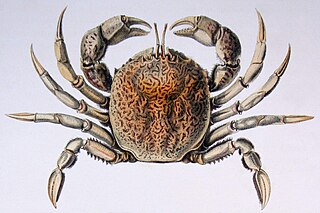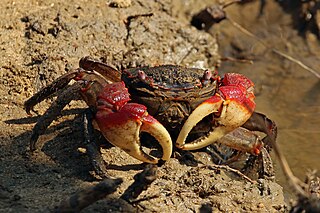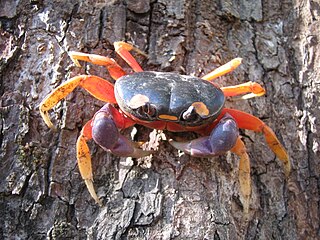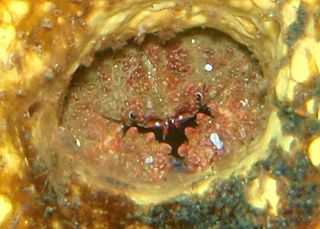
Mictyris is a genus of brightly coloured crabs, placed in its own taxonomical family, the Mictyridae. It inhabits the central Indo-West Pacific region. These crabs congregate on mud flats or beaches in groups of a few thousand, and filter sand or mud for microscopic organisms. They congregate during low tide, and bury themselves in the sand during high tide or whenever they are threatened. This is done in wet sand, and they dig in a corkscrew pattern, leaving many small round pellets of sand behind them.

Tuerkayana hirtipes is a species of terrestrial crab.

Cancridae is a family of crabs. It comprises six extant genera, and ten exclusively fossil genera, in two subfamilies:

Belliidae is a family of crabs of the order Decapoda.

Discoplax longipes is a species of terrestrial crab. It is found in karstic caves on Pacific islands and ranges from the Loyalty Islands to French Polynesia. Mating occurs in the caves, after which the females migrate to the sea to release their fertilised eggs. The genus Discoplax was for a long time synonymised with Cardisoma, but was resurrected in the late 20th century.

The Gecarcinidae, the land crabs, are a family of true crabs that are adapted for terrestrial existence. Similar to all other crabs, land crabs possess a series of gills. In addition, the part of the carapace covering the gills is inflated and equipped with blood vessels. These organs extract oxygen from the air, analogous to the vertebrate lungs. Adult land crabs are terrestrial, but visit the sea periodically, where they breed and their larvae develop. Land crabs are tropical omnivores which sometimes cause considerable damage to crops. Most land crabs have one of their claws larger than the other.

Cardisoma is a genus of large land crabs. Three species formerly placed in this genus are now placed in Discoplax. The four species that remain in Cardisoma are found in warm coastal regions where they live in burrows. Young individuals are often very colourful with a purple-blue carapace and orange-red legs, but as they grow older the colours tend to fade, and females may be duller than males. Although less extreme than in fiddler crabs, one claw is usually considerably larger than the other. They are omnivores, but primarily feed on plant material.

Pseudothelphusidae is a family of freshwater crabs found chiefly in mountain streams in the Neotropics. They are believed to have originated in the Greater Antilles and then crossed to Central America via a Pliocene land bridge. Some species of this family are troglobitic.

The Sesarmidae are a family of crabs, previously included in the Grapsidae by many authors. Several species, namely in Geosesarma, Metopaulias, and Sesarma, are true terrestrial crabs. They do not need to return to the sea even for breeding.

Gecarcinus is the type genus of the land crab family Gecarcinidae. They are found in warmer coastal regions of the Americas, including islands in the Caribbean. Four species from oceanic islands were formerly included in Gecarcinus as the subgenus Johngarthia, but are now treated as a separate genus, Johngarthia. While all members of this genus are largely terrestrial, they have to return to the ocean to breed. They are often colourful, with reddish, orange, purple, yellowish, whitish, or blackish being the dominating hues. This has resulted in some species, notably G. quadratus and G. lateralis, gaining a level of popularity in the pet trade.

Johngarthia is a genus of crabs in the land crab family Gecarcinidae, formerly included in the genus Gecarcinus, and containing six species. The genus bears the name of John S. Garth, a 20th century naturalist who specialized in crabs and other arthropods.

Austruca mjoebergi is a species of fiddler crab discovered by and named after the Swedish zoologist Eric Mjöberg (1882–1938), member of a Swedish scientific expedition to Australia in the early 1900s.
Villalobosius is a genus of crabs in the family Pseudothelphusidae, containing a single species, Villalobosius lopezformenti. It lives in the northern part of the state of Oaxaca, Mexico, on the Isthmus of Tehuantepec, and is adapted to a troglobitic lifestyle.

Karstarma is a genus of karst-dwelling crabs formerly included in Sesarmoides.

Gelasimus vocans is a species of fiddler crab. It is found across the Indo-Pacific from the Red Sea, Zanzibar and Madagascar to Indonesia and the central Pacific Ocean. It lives in burrows up to 50 centimetres (20 in) deep. Several forms of G. vocans have been recognised, with their authors often granting them the taxonomic rank of full species or subspecies.

Glyptoxanthus is a genus of crabs in the family Xanthidae, containing eight species. It was originally erected by Alphonse Milne-Edwards in 1879 for six species previously placed in the genus Actaea and elsewhere. Although previously included in subfamily Euxanthinae, the genus has a quite distinct morphology from other genera in that group, and was placed in 2011 in the new, monotypic subfamily, Glyptoxanthinae by Jose Christopher Mendoza and Danièle Guinot.

Demania is a genus of crabs in the family Xanthidae, containing the following species:

Pilumnoides is a genus of crabs in the family Pilumnoididae. The genus was erected by Hippolyte Lucas in 1844. It contains the following species:

Austruca annulipes is a species of fiddler crab found along the coastline from South Africa to Somalia, Madagascar, India, China, Indonesia, Malaysia, and the Philippines.

Tuerkayana is a genus of large land crabs. It was created from two members of the genus Cardisoma and two members of Discoplax in late 2018 after a re-examination of the taxonomy of the family Gecarcinidae. Said re-examination also resulted in the creation of the new family Leptograpsodidae for the genus Leptograpsodes.





















